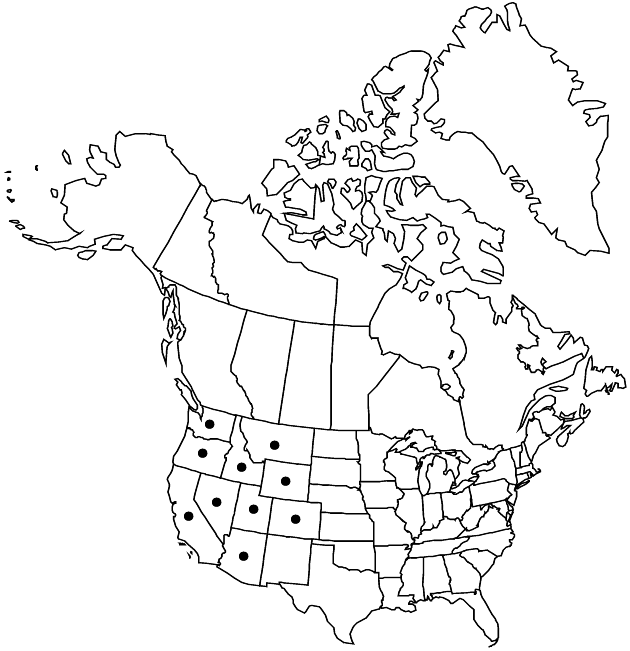Erigeron eatonii
Notes Compositae, 91. 1880.
Perennials, 4–23 (–33) cm; taprooted, caudices simple or branched. Stems erect to ascending or decumbent, strigose, rarely hirtellous, sometimes minutely glandular. Leaves basal (persistent) and cauline; basal blades (3-nerved) linear to oblanceolate, 50–110 (–190) × (1–) 2–8 (–13) mm, cauline gradually reduced distally, margins entire, faces loosely strigose to sparsely hirsuto-villous, eglandular. Heads 1–4 (–7). Involucres 4.5–8 × 8–14 (–17) mm (7–11 × 17–23 mm in var. nevadincola). Phyllaries in 2–3 (–4) series, hirsutulous to villous, sometimes minutely glandular. Ray-florets 16–42; corollas white or pink to bluish or purple, 5–8 (–9) mm, laminae not coiling or reflexing. Disc corollas 2.5–5 mm (–6.8 mm in var. nevadincola). Cypselae 1.7–3.5 mm (–4.5 mm in var. nevadincola), 2-nerved, faces sparsely strigose; pappi: outer of setae, inner of 12–30 bristles.
Distribution

Ariz., Calif., Colo., Idaho, Mont., Nev., Oreg., Utah, Wash., Wyo.
Discussion
Varieties 6 (6 in the flora).
J. L. Strother and W. J. Ferlatte (1988) provided a detailed study of Erigeron eatonii and its closest relatives (the following key is adapted from their study). Erigeron eatonii is regarded here as comprising a group of varieties with relatively discrete, nearly non-overlapping distributions, intergrading where their ranges are contiguous (for maps, see Strother and Ferlatte). Varieties villosus and lavandulus are exceptions: var. villosus occurs north of all other varieties except var. lavandulus, which occurs completely within the range of var. villosus and might justifiably be treated at specific rank. Variety nevadincola often has been treated at specific rank; its distinctions are quantitative (larger heads, florets, and fruits) and it intergrades with var. sonnei. Erigeron canaani occurs at the southwestern extreme of the range of E. eatonii var. eatonii and may be better treated at varietal rank within E. eatonii; as noted by Strother and Ferlatte, linear-leaves (diagnostic feature of E. canaani) occur in plants of var. eatonii in other parts of its range.
Selected References
Lower Taxa
Key
| 1 | Involucres 4.5–11 mm; disc corollas (3.5–)4.5–6.8 mm; pappi of 18–30 bristles 3.5–5 mm | > 2 |
| 1 | Involucres 4–5(–7) mm; disc corollas 2.5–4(–5) mm; pappi of 12–20(–28) bristles 2.5–4(–5) mm | > 3 |
| 2 | Involucres 7–11 × (14–)17–23 mm; ray laminae 7–11 mm; disc corollas 4.4–6.8 mm | Erigeron eatonii var. nevadincola |
| 2 | Involucres 4.5–8 × 8–12(–16) mm; ray laminae 4.5–6.6(–8.5) mm; disc corollas 3.5–5 mm | Erigeron eatonii var. sonnei |
| 3 | Phyllaries moderately to densely minutely glandular, sparsely to moderately villous | > 4 |
| 3 | Phyllaries sometimes sparsely minutely glandular, hirtellous to villous | > 5 |
| 4 | Heads 1–2(–7), held well beyond basal leaves | Erigeron eatonii var. eatonii |
| 4 | Heads (1–)2–4(–6), held slightly if at all beyond basal leaves | Erigeron eatonii var. lavandulus |
| 5 | Heads 1–4; phyllaries sparsely to moderately hirtellous (hairs mostly 0.3–0.8 mm) | Erigeron eatonii var. plantagineus |
| 5 | Heads 1(–2); phyllaries moderately to densely villous (hairs mostly 1–2 mm) | Erigeron eatonii var. villosus |